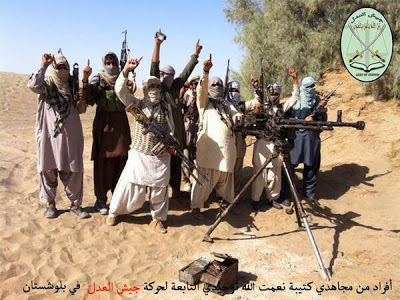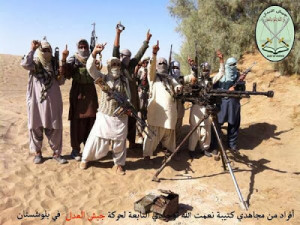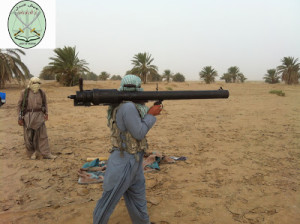State News Agency IRNA reports that fourteen Iranian border guards were killed and five wounded in clashes with “armed bandits” on Iran’s southeastern border with Pakistan overnight.
The report gave no more details on the identity of those who fought with the border guards. However, Fars News, linked to the Revolutionary Guards — saying 17 guards were killed, 5 wounded, and 4 taken hostage — reports that the Iranian Sunni insurgent group Jaish ul-Adl (“Army of Justice”), formed last year, has claimed responsibility.
Although the attack is being reported only now, is likely that it took place earlier this month, before October 12, since on that date Jaish ul-Adl posted news to their blog stating that they had carried out a successful attack against an Iranian police station in Rutak, which is above Saravan (click for map showing location of Rutak).
The post says that the insurgents attacked an Iranian checkpoint, killing more than a dozen personnel.
The group wrote that the operation lasted for over an hour and that the Iranian security forces surrounded the area including with military helicopters, banning any travel to the area.
Jaish ul-Adl accused the Iranian forces of “cruelty and barbarism” and warned them to leave the area as soon as possible, threatening further attacks if they did not comply.
The group posted several photographs of those it claimed were responsible for the attack.
Jaish ul-Adl — or “media mujahideen” activists supporting their cause — have used social media to publicize their involvement in the attack in the mountains above Saravan in Sistan Baluchestan Province (click for map).
#التغريدة_السابقة: قاد العملية أبطال كتيبة [ضيائي] أمس في منطقة [كوهگ-سراوان] #بلوشستان ٢٥-١٠-٢٠١٣م . @safa_tv pic.twitter.com/QZeOVtsDia
— جيـش العـدل/أبويحيى (@BalouchRightsAd) October 26, 2013
#جيش_العدل لها أكثر من ٢٠ عملية نوعية وعمليتين على معسكرات إيرانية بقلة العتاد ، من يصدق مع الله يصدق معه! . pic.twitter.com/9YGKnKumgF
— جيـش العـدل/أبويحيى (@BalouchRightsAd) October 25, 2013
The group also posted a video to its Facebook account.
In March, Jaish ul-Adl claimed responsibility for another attack on IRGC personnel in Saravan.
That attack came after Jaish ul-Adl claimed in January that they had carried out an assault against a Basij officer in the region.
What is notable about the most recent attack is that it has been reported in the Iranian media. Usually, Iran’s State media is rather silent about attacks by Sunni insurgents, after the Islamic Republic claimed to have stamped out Sunni separatist movement in 2010, when it executed the leader of Sunni militant group Jundullah, Abdolmalek Rigi.
Over the past year, Iran has seen an upsurge in Sunni separatism is Sistan-Baluchestan, including from the group Harakat Ansar Iran.
One hint of the growing threat to Iran from Sunni jihad and separatist movements came last week, wehn IRGC Commander Major General Mohammad Ali Jafari said the Revolutionary Guards had successfully foiled 11 terrorist attacks in south-eastern Iran in the first half of the Iranian calendar year (March 21-September 22, 2013).
Jafari blamed “agents of Iran’s enemies and counter-revolutionary groups” who he said were trying tocreate insecurity in Sistan -Baluchestan.
Although these causes are local, and the groups are fighting for local issues, the groups are increasingly linked — by ideology and via networks of “media mujahideen” who take on the task of portraying their cause — to a conceptual framework of “global jihad” and a wider sectarian fight of Sunni versus Shia Islam.



